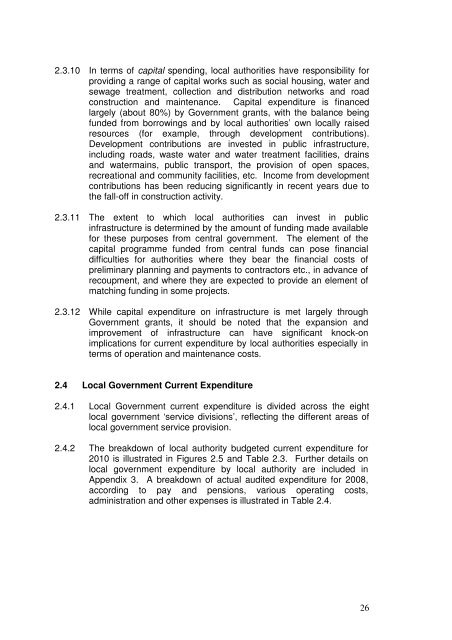Report of the Local Government Efficiency Review Group
Report of the Local Government Efficiency Review Group
Report of the Local Government Efficiency Review Group
You also want an ePaper? Increase the reach of your titles
YUMPU automatically turns print PDFs into web optimized ePapers that Google loves.
2.3.10 In terms <strong>of</strong> capital spending, local authorities have responsibility for<br />
providing a range <strong>of</strong> capital works such as social housing, water and<br />
sewage treatment, collection and distribution networks and road<br />
construction and maintenance. Capital expenditure is financed<br />
largely (about 80%) by <strong>Government</strong> grants, with <strong>the</strong> balance being<br />
funded from borrowings and by local authorities’ own locally raised<br />
resources (for example, through development contributions).<br />
Development contributions are invested in public infrastructure,<br />
including roads, waste water and water treatment facilities, drains<br />
and watermains, public transport, <strong>the</strong> provision <strong>of</strong> open spaces,<br />
recreational and community facilities, etc. Income from development<br />
contributions has been reducing significantly in recent years due to<br />
<strong>the</strong> fall-<strong>of</strong>f in construction activity.<br />
2.3.11 The extent to which local authorities can invest in public<br />
infrastructure is determined by <strong>the</strong> amount <strong>of</strong> funding made available<br />
for <strong>the</strong>se purposes from central government. The element <strong>of</strong> <strong>the</strong><br />
capital programme funded from central funds can pose financial<br />
difficulties for authorities where <strong>the</strong>y bear <strong>the</strong> financial costs <strong>of</strong><br />
preliminary planning and payments to contractors etc., in advance <strong>of</strong><br />
recoupment, and where <strong>the</strong>y are expected to provide an element <strong>of</strong><br />
matching funding in some projects.<br />
2.3.12 While capital expenditure on infrastructure is met largely through<br />
<strong>Government</strong> grants, it should be noted that <strong>the</strong> expansion and<br />
improvement <strong>of</strong> infrastructure can have significant knock-on<br />
implications for current expenditure by local authorities especially in<br />
terms <strong>of</strong> operation and maintenance costs.<br />
2.4 <strong>Local</strong> <strong>Government</strong> Current Expenditure<br />
2.4.1 <strong>Local</strong> <strong>Government</strong> current expenditure is divided across <strong>the</strong> eight<br />
local government ‘service divisions’, reflecting <strong>the</strong> different areas <strong>of</strong><br />
local government service provision.<br />
2.4.2 The breakdown <strong>of</strong> local authority budgeted current expenditure for<br />
2010 is illustrated in Figures 2.5 and Table 2.3. Fur<strong>the</strong>r details on<br />
local government expenditure by local authority are included in<br />
Appendix 3. A breakdown <strong>of</strong> actual audited expenditure for 2008,<br />
according to pay and pensions, various operating costs,<br />
administration and o<strong>the</strong>r expenses is illustrated in Table 2.4.<br />
26
















